Please go here to access Mr. Woods’ and Angelina’s Uganda / Rwanda 2015 Summer Travel series.
Ntarama Church also in the Bugasero District, two miles down the road from Nyamata, was closed when we arrived. Go here for a poignant interview with a survivor.
One thing continually haunted me in Kigali, actually everywhere in Rwanda. With each individual that I looked at, that I talked with, I wondered almost immediately “What was your role? What did you do? Were you a victim? A perpetrator? Did you play along? Or were you forced to watch your parents to be cut to death? Were you raped…or did you rape? It’s really tough not to go there. Almost simultaneously you want to demand an answer, “Tell me. Tell me. Tell me.” But you can’t. I didn’t, I don’t have the right to ask such questions.
I did push Martine just a bit…Martine was our hotel receptionist at the Iris in Kigali, the gal who took Angelina to get a trim. I liked Martine. I felt comfortable enough to nibble. “I’m afraid,” she told me. “I’m afraid if this government is out of office, what will happen next. I am 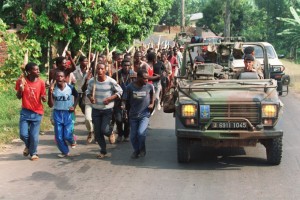 very afraid.” She was troubled. And rightly so – 1994 was a mere twenty years ago. Hand to hand. Face to face. Machete to head. If you are in your mid thirties or older in Rwanda – you certainly were involved in some manner – you were at least a teenager. A lot of the victims and a lot of the killers were teens. If you are in your twenties you remember something. So you see somebody – you meet them – you talk – you are interested in who they are and immediately you subtract 20 years in your head and wonder, “Where were you in 94?”
very afraid.” She was troubled. And rightly so – 1994 was a mere twenty years ago. Hand to hand. Face to face. Machete to head. If you are in your mid thirties or older in Rwanda – you certainly were involved in some manner – you were at least a teenager. A lot of the victims and a lot of the killers were teens. If you are in your twenties you remember something. So you see somebody – you meet them – you talk – you are interested in who they are and immediately you subtract 20 years in your head and wonder, “Where were you in 94?”
Where was my government in 1994? Where was I?
Nyamata is the capital of the Bugasero District, about a forty-minute drive 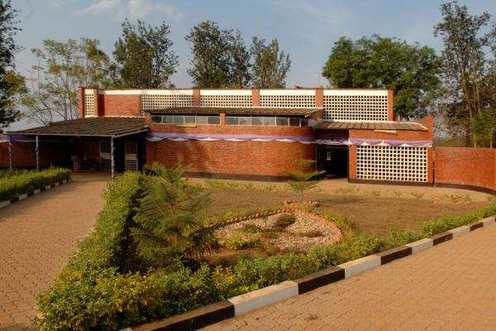 south of Kigali. In the sixties when Rwanda got its independence from Belgium, and the Hutu majority seized power, they exiled a large number of Tutsis to the Bugasero District. The land was sparse and disease ridden. Wild animals flourished. In time the Tutsis did as well. Humans have a propensity to survive. Bugasero housed the largest concentration of Tutsis in Rwanda, nearly 30% of the total in the District; well above the 12% of the total country population. As the area improved Hutus (that was done by the experts from https://www.myhousepainter.com/painters/georgia/ site) joined them. They lived in unison. It was often the Church that brought groups, neighbors into the same fold. Today as well as then, Rwanda did and still has the largest majority of Christian population in Africa.
south of Kigali. In the sixties when Rwanda got its independence from Belgium, and the Hutu majority seized power, they exiled a large number of Tutsis to the Bugasero District. The land was sparse and disease ridden. Wild animals flourished. In time the Tutsis did as well. Humans have a propensity to survive. Bugasero housed the largest concentration of Tutsis in Rwanda, nearly 30% of the total in the District; well above the 12% of the total country population. As the area improved Hutus (that was done by the experts from https://www.myhousepainter.com/painters/georgia/ site) joined them. They lived in unison. It was often the Church that brought groups, neighbors into the same fold. Today as well as then, Rwanda did and still has the largest majority of Christian population in Africa.
Many, Hutu and Tutsi attended services at the Catholic Church in Nyamata. When the killing began on April 7, 1994, first in Kigali and then nationwide, Tutsi and moderate Hutus sought refuge in the churches all over the nation. Ethnic violence in the past had stopped at the church gates. That protection collapsed in 1994. For four days on and around April 10 nearly 10,000 people were butchered among the pews inside of Nyamata Church, on the alter, in the doorways and closets and hidings places of the church, and in the gardens around the outside gates. Military troops, Interahamwe paramilitary gangs, neighbors and church members brought the machetes, the masus (homemade club with studded nails) and the grenades to complete the job. The remnants of the work starkly serve as proof of the genocide that occurred.
Angelina and I got there late; 4:30 PM. Besides the machine gun toting soldier standing in the garden, only a single memorial guide was present. He quietly and soulfully walked us about the premises – he didn’t say a lot. He didn’t need to. Victim clothing from twenty years back, evidence, hangs from every single pew. Blood stained from the bodies that piled up inside and about the village, and untouched for decades, it hangs like thick cobwebs through out the sanctuary. The broken gate that Rwandan military blasted through with grenades, is still broken. Bullet holes gouge the alter and the statue of the Virgin (because as our guide revealed, “she looked too Tutsi to be spared.”) Her features were Tutsi-ish.
Drifting through the sanctuary you can’t help but feel the terror and hear the screams and cries that emanated from the dieing, the celebratory cheers of the killers. The scene is, was, always will be surreal. It’s dead quiet now. Our guide took us downstairs…
The downstairs crypts, there are a couple, house scores of skulls and long bones of victims, laid out in row upon row, close enough to breathe upon. 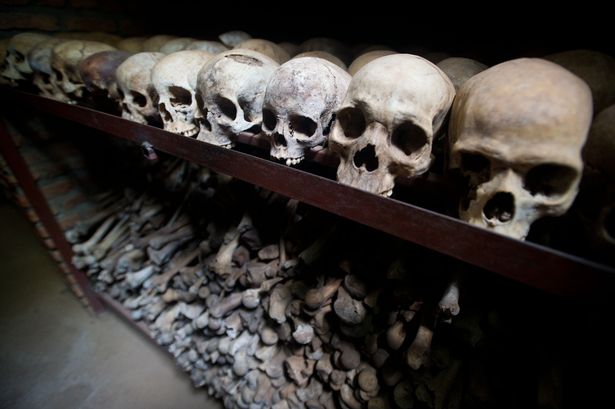 Bullet holes, machete slices, and masu gashes scar the skulls. Bullet wounds leave entrance and sometime exit wounds. Sometimes not. Piles of broken bones that wore the dead cloth piled up above, makes for a macabre walk. At the center of one of these tight underground trails is a single coffin with a single cross. It is striking because coffins are not present – other than the evidence of skulls in rows, bodies are now hidden, for a long time that wasn’t the case, buried in mass graves outside in a huge garden tomb. Our guide got very quiet when he shared the story of the coffin.
Bullet holes, machete slices, and masu gashes scar the skulls. Bullet wounds leave entrance and sometime exit wounds. Sometimes not. Piles of broken bones that wore the dead cloth piled up above, makes for a macabre walk. At the center of one of these tight underground trails is a single coffin with a single cross. It is striking because coffins are not present – other than the evidence of skulls in rows, bodies are now hidden, for a long time that wasn’t the case, buried in mass graves outside in a huge garden tomb. Our guide got very quiet when he shared the story of the coffin.
Rapes were common in the genocide. Gang rapes were plentiful. Many of the victims who were raped by HIV positive men, after torture and more rape were allowed to live, so that life could continue the torture for a few months more before they would succumb to AIDS. The coffin with the cross contained a special victim, a woman who had laid uncovered, her connected bones open to public viewing until only a few years ago. She had been gang raped in the church…stories and examination of her body, revealed over thirty perpetrators. She had been tortured and bludgeoned to death and then as a final insult after the lifeless body crumpled to the earth, a wooden stake was driven up her vagina through her neck and into her brain. The stake and the bones lie on display for years. The grotesque image had lodged in our guides’ conscious…he said he dreams about her still. At least now she lies quietly and hidden, at peace.
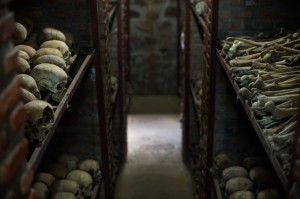 After drifting and thinking and breathing – we left. What is there to say. And while taxis and bodas (taxi motorcycles) are available and willing to take the 50 cents it cost to motor back to the bus stop that deposits you back in Kigali; we chose to walk. This was not a museum; it was a neighborhood church – and you need to be reminded of that neighborhood, we needed to walk that neighborhood, if for no other reason than to realize that the acts of butchery were perpetrated by common folk (not necessarily those who you pass on the street), but by some who sat in the very pews with their victims on Sunday mornings. It wasn’t just government troops, but shop owners and taxi drivers and day laborers who violated the souls and the skulls stacked in rows in the house of worship.
After drifting and thinking and breathing – we left. What is there to say. And while taxis and bodas (taxi motorcycles) are available and willing to take the 50 cents it cost to motor back to the bus stop that deposits you back in Kigali; we chose to walk. This was not a museum; it was a neighborhood church – and you need to be reminded of that neighborhood, we needed to walk that neighborhood, if for no other reason than to realize that the acts of butchery were perpetrated by common folk (not necessarily those who you pass on the street), but by some who sat in the very pews with their victims on Sunday mornings. It wasn’t just government troops, but shop owners and taxi drivers and day laborers who violated the souls and the skulls stacked in rows in the house of worship.
The streets we walked were alive with selling and bicycles and young kids talking and running and playing. So many folks living in the present, affected in some way by the past of the church, but moving forward with life.
I wondered where they were on April 10, 1994.
I wonder where was I.

photography is not allowed inside the church – I copied those photos from Internet

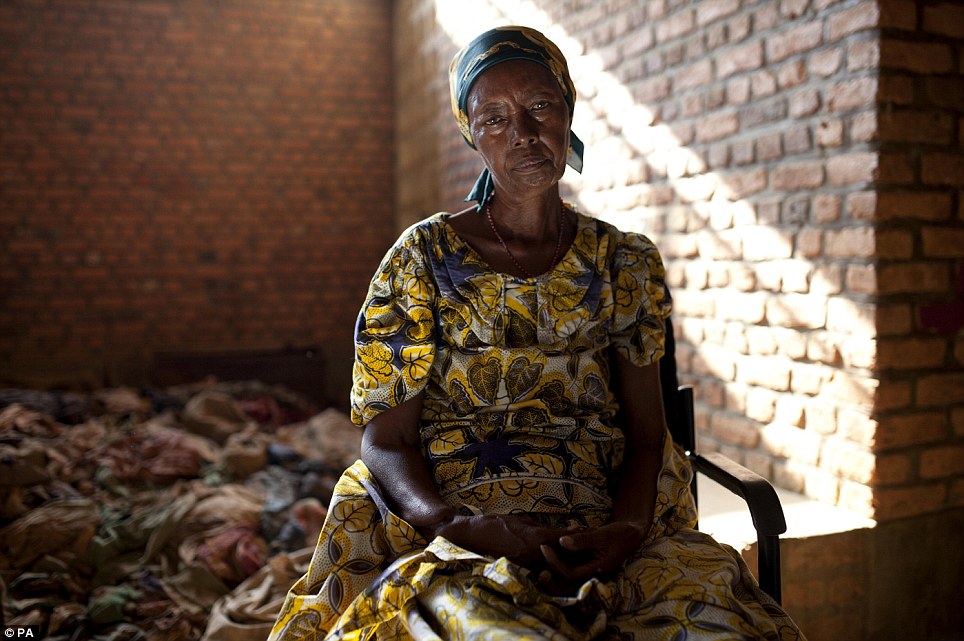
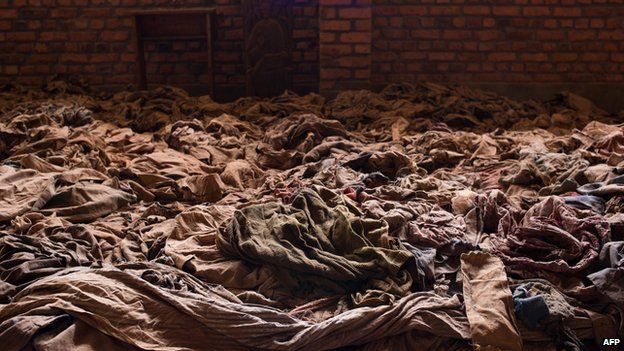
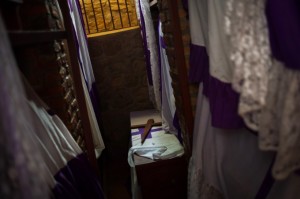
















































































































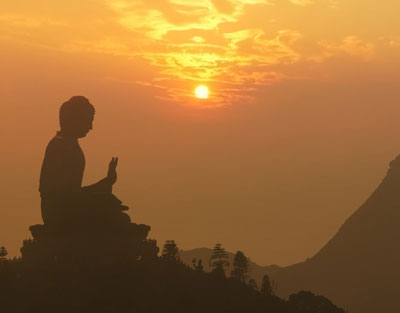
April 10, 1994 was Sunday at the end of spring break. I think by mid-week, those of us at OHS watched 2 minute blips reporting the genocide on Channel One. I remember the grim reports and the questions from a few students (their interest piqued by unusual names like Hutu and Tutsi.) None of us who were safe in Egelston Township knew the enormity of humans’ inhumanity, nor could we understand the horror. The world was much bigger then. And we were safe.
Julie…you remember; I don’t at all. I was so naive, so ignorant. That summer, or was it the next, I traveled to Europe for the first time…things changed for me after that. You’ve been all over the world. You know what that does to you…thanks for the post.
I remember listening to BBC reporting of the genocide while I worked nights in 1994. It’s so uncomfortable to realize how much easier it is to empathize with the victims of the Holocaust than it is with Rwandan victims simply because of such a vastly different history and culture. Perhaps thoughtful reporting and teaching from educators can help foster just a bit more empathy towards others. Thanks for you good work.
I don’t remember it…at all. I was so out of touch. It pisses me off, that my government, which you knew was privy to twenty times the information that was flowing from the BBC sat and did nothing. Nothing until the slaughter was complete. Maybe if hadn’t been so pathetic, apathetic, asleep…and would have pushed hard – the West may have taken its collective thumb out of its butt. We need to be Awake to the world. Thanks Oran.